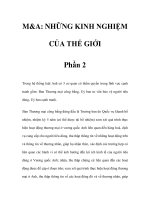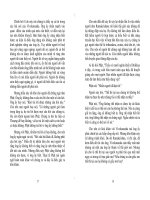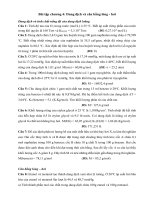Pdfcoffee com aashto m 145 2 pdf free
Bạn đang xem bản rút gọn của tài liệu. Xem và tải ngay bản đầy đủ của tài liệu tại đây (530.28 KB, 8 trang )
Standard Specification for
Classification of Soils and Soil-Aggregate
Mixtures for Highway Construction Purposes
7
91 (2004)
M-145-n:
O gnatio
si
AASHT
De
——_
SCOPE
1.1.
based on
This recommended practice describes a procedure for classifying soils into seven groups
Evaluation
index.
plasticity
and
limit,
liquid
,
distribution
ze
particle-si
of
ion
determinat
laboratory
from
of soils within each group is made by means of a “group index,” which is a value calculated
in
useful
be
should
an empirical formula. The group classification, including group index
y
determining the relative quality of the soil material for use in earthwork structures, particularl
important
of
design
detailed
the
for
However,
embankments, subgrades, subbases, and bases.
~
Q2
structures additional data concerning strength or performance characteristics of the soil under field
conditions will usually be required.
1.2.
The values stated in SI units are to be regarded as the standard.
REFERENCED
2.1.
DOCUMENTS
AASHTO Standards:
T 11, Materials Finer Than 75-1xm (No. 200) Sieve in Mineral Aggregates by Washing
T 27, Sieve Analysis of Fine and Coarse Aggregates
T 87, Dry Preparation of Disturbed Soil and Soil Aggregate Samples for Test
T 88, Particle Size Analysis of Soils
@
T 89, Determining the Liquid Limit of Soils
T 90, Determining the Plastic Limit and Plasticity Index of Soils
T 146, Wet Preparation of Disturbed Soil Samples for Test
2.2.
ASTM Standard:
=
D1140, Amount of Material in Soils Finer Than the No. 200 (75-hm) Sieve
Note 1—Either T 88, or T 11 and T 27, or ASTM D 1140 will be used to determine the particle
size distribution of soils or soil-aggregate mixtures as a basis for classification.
CLASSIFICATION
3.1.
The classification is made by using the test limits and group index values shown in Table 1. Ifa
more detailed classification is desired, a further subdivision of the groups shown in Table ] may
made.
be made. An example of the classification with such subgroups as shown in Table 1 may be
and
limit
liquid
The
2.
Table
in
shown
is
subgroups
such
with
on
classificati
the
An example of
plasticity index ranges for the A-4, A-5, A-6, and A-7 soil groups are shown graphically in
Figure 2.
TS-1b
M 145-1
AASHTO
4001 Ơ] 1E]
CZ ama
dN
——
pues
oul]
XeuI 0
—
pues pur JaAø18
‘sjuawsey 900)
dN
—
XEU1 0€
Làng 74
Xe 9
_—
S[EMOWBUE JUSNYSUOD JURdIpUTIs Jo sadAy †pnsƒ
xopur Ajonse|d
yun prnbry
(Op ON) WW CZp'Q BuIssed UOKHSRI Jo S21151121261E02)
(01 '0N) tưưi 0072
(00£ '0N) 0Ì c¿
(0y 'ON) tui cZp'0
:ểuISSEd 109212d *SISÁIgữt 2A21G
]E120913
UOIJ62ITISSET2) dnoIr›
HOHB9EHSSEI“)
SAINFXIP] 91882182V-[IOS put SjIOS J0 uOI}EOIISS8[2—Z 9|QE
&
SAIN)XI] 21082188V-JIoS pue S[IOS JO u01182171SSE]2——[L 9q]
UOR9OIJISS6I2) dn0Ip)
UOI82111S5SPJZ) JE12Uar)
:8uIsSBd 109319 “§ISÁ†eUE aAaI
(OT ‘ON) ww 00'%
(0y ON) taut S79
(00Z '0N) tiỈ cý
xopur Ayonseld
1m pIBL]
(Op ON) wi ¢Z7p'Q SuIssed UOHOLYJo 5215121201002)
2p01đqns se 8uIE1 [E1aưar)
'SARIDA 101 7 9Q81 99S
saop pub ,,5S2201đ 00iiBUTU113 YSU OF 13; 21 HỊ Ấ†ESS252U st Z~V 21012q £-V Jo 8u2etd ai —
|dI-V | t#Ị-V
Iv
apeisqns se 8u1e1 Jp1auary
22S) '0£ snuTú "TT ưet) 126228 sị dnor8gns 0-/-V JO X9pUI Á112SBjđ '0£ snttu “Ty URL ssay 40 0] [enba sị đnoz8qns c-(~V Jo X2pUL 112IS01đ
ĐO0Ø 01 102[22XÑ
XEuI 0Ị
XEU1 0ỳ
pues pur JaAø18 Á9Áp[2 10 Á!I
KEUIQ[ y Ulu TT
WIU [Ị
XEU 0
feu Op | Up | xeut op | ur [p
—
XEUISE | XEUIQ[ | XEUICZ | XEUI €Ị
—
MIUIS | XEUI 0G | XE 0C
—
HHMOC | XEUH CC | XEUIGỆ | XEUICC |
—
—
—
_
—
4
XE 0C
—
†PV
|9¿ZV | SẽV |
XU 0
XE Op
|UZV
18[nuE1)
cv
(urrÍ ý/ 3uIss4 sSø'T 10 J12212q €€)
S[EH918JA
—
—
CV
210)
—
tếV
SJi0S AIJIS
unu [Ị
XBUI QT
XBW Op | UW [p
S[IOS Á3Áb1,)
oul TT
UI Tp
ull oÂ
Ula OF
ơ
g-V
Cg URL
(want c/
9v
UIMI 9C
9,.v
'6--V
V
Wed19g
SJEHS18IN [2-1JIS
Suisseg
"Ê-V 19A0 -V J0 AHOLHednS 2102IpHT 0
XEuI 0
Ulu Jÿ
POOD 01 1ue|Ja9xi]
uUIMt [[
XeUI 0b
Joog ) ey
un [|
ul Jp
xe OT
—
cv
ot VW
Irv
(win ¢/ Sursseg sSerT 10 109212 c£)
SỊPI11BN 1EJUEIO
—
XEUI CỆ
—
Un o¢
—
—
UM 9¢
—
—
UU OF
—
—
UM O¢
—
uy J€
—
LV
9y
{cv
p-v
(0Ï $¿ 8uss6q 1u29l2q c€ tre], 210JAJ)
S[ELI2IEEN ẤPI2-1IIS
®
„
Ð
AASHTO
M 145-2
TS-1b
3.2.
ith required test data available, proceed from left to right in Table 1
Classification Procedure—W
or Table 2 and the correct group will be found by process of elimination. The first group from the
left into which the test data will fit is the correct classification. All limiting test values are shown
as whole numbers. If fractional numbers appear on test reports, convert to nearest whole number
for purposes of classification. Group index values should always be shown in parentheses after
group symbol as: A-2-6(3), A-4(5), A-6(12), A-7-5(17), etc.
DEFINITIONS OF GRAVEL, SAND, AND SILT-CLAY
4.1.
The terms “gravel,” “coarse sand,” and “silt-clay,” as determinable from the minimum test data
required in this classification arrangement and as used in subsequent word descriptions, are
defined as follows:
4.1.1.
gravel—material passing sieve with 75-mm (3-in.) square openings and retained on the 2.00-mm
(No. 10) sieve.
coarse sand—miaterial passing the 2.00-mm (No. 10) sieve and retained on the 0.425-mm (No. 40)
sieve.
fine sand—material passing the 0.425-mm (No. 40) sieve and retained on the 75-pm (No. 200)
sieve.
silt clay (combined silt and clay)—material passing the 75-ym (No. 200) sieve.
Boulders and Cobbles (retained on 75-mm (3-in.) sieve) should be excluded from the portion of
the sample to which the classification is applied, but the percentage of such material, if any, in the
sample should be recorded.
The term “silty” is applied to fine material having plasticity index of 10 or less and the term
“clayey” is applied to fine material having plasticity index of 11 or greater.
DESCRIPTION OF CLASSIFICATION GROUPS
5.1.
Granular Materials—Containing 35 percent or less passing 75-um (No. 200) sieve, Note 2.
5.1.1.
Group A-1—The typical material of this group is a well-graded mixture of stone fragments or
gravel, coarse sand, fine sand, and a nonplastic or feebly plastic soil binder. However, this group
also includes stone fragments, gravel, coarse sand, volcanic cinders, etc. without soil binder.
5.1.1.1.
Subgroup A-1-a includes those materials consisting predominantly of stone fragments or gravel,
5.1.1.2.
Subgroup A-1-b includes those materials consisting predominantly of coarse sand either with or
without a well-graded soil binder.
5.1.2.
Group A-3—The typical material of this group is fine beach sand or fine desert blow sand without
silty or clay fines or with a very small amount of nonplastic silt. The group includes also stream-
either with or without a well-graded binder of fine material.
deposited mixtures of poorly graded fine sand and limited amounts of coarse sand and gravel.
TS-1b
M 145-3
AASHTO
Group A-2—This group includes a wide variety of “granular” materials which
are borderline
between the materials falling in Groups A-1 and A-3 and silt-clay materials of
Groups A-4, A-5,
A-6, and A-7. It includes all materials containing 35 percent or less passing the
75-um (No. 200)
sieve which cannot be classified as A-1 or A-3, due to fines content or plasticity
or both, in excess
of the limitations for those groups.
5.1.3.1.
Subgroups A-2-4 and A-2-5 include various granular materials containing
35 percent or less
passing the 75-jm (No. 200) sieve and with a minus 0.425-mm (No. 40) portion
having the
characteristics of the A-4 and A-5 groups. These groups include such materials
as gravel and
coarse _sand with silt contents or plasticity indexes-in-exeess of the Himitation
s uf Group A-1; and
fine sand with nonplastic silt content in excess of the limitations of Group
A-3.
5.1.3.2,
Subgroups A-2-6 and A-2-7 include materials similar to those described under
Subgroups A-2-4
and A-2-5 except that the fine portion contains plastic clay having the characteri
stics of the A-6 or
A-7 group.
Note 2—Classification of materials in the various groups applies only to the
fraction passing the
75-mm (3-in.) sieve. Therefore, any specifications regarding the use of A-1,
A-2, or A-3 materials
in construction should state whether boulders retained on the 75-mm (3-in.)
sieve are permitted.
5.2.
5.2.1.
5.2.2.
5.2.3.
5.2.4.
Silt-Clay Materials—Containing more than 35 percent passing the 75-um
(No. 200) sieve.
Group A-4—The typical material of this group is a nonplastic or moderately plastic
silty soil
usually having the 75 percent or more passing the 75-um (No. 200) sieve.
The group includes
also mixtures of fine silty soil and up to 64 percent of sand and gravel retained
on 75-um
(No. 200) sieve.
Group A-5-—The typical material of this group is similar to that described
under Group A-4,
except that it is usually of diatomaceous or micaceous character and may be
highly elastic as
indicated by the high liquid limit.
Group A-6—The typical material of this group is a plastic clay soil usually having
75 percent or
more passing the 75-1um (No. 200) sieve. The group includes also mixtures
of fine clayey soil and
up to 64 percent of sand and gravel retained on the 75-um (No. 200) sieve.
Materials of this group
usually have high-volume change between wet and dry states.
Group A-7—The typical material of this group is similar to that described
under Group A-6,
except that it has the high liquid limits characteristic of the A-5 group and may
be elastic as well
as subject to high-volume change.
5.2.4.1.
Subgroup A-7-5 includes those materials with moderate plasticity indexes
in relation to liquid
limit and which may be highly elastic as well as subject to considerable volume
change.
5.2.4.2.
Subgroup A-7-6 includes those materials with high plasticity indexes in relation
to liquid limit and
which are subject to extremely high-volume change.
Note 3—Highly
of these materials
75-ppm (No. 200)
partially decayed
odor of decay. |
organic soils (peat or muck) may be classified in an A-8 group. Classification
is based on visual inspection, and is not dependent on percentage passing the
sieve, liquid limit, or plasticity index. The material is composed primarily of
organic matter, generally has a fibrous texture, dark brown or black color, and
an
These organic materials are unsuitable for use in embankments and subgrades. They
are highly
compressible and have low strength.
TS-1b
M 145-4
AASHTO
GROUP INDEX
6.1.
The group index is calculated from the following formula:
Group index = (F — 35) [0.2 + 0.005 (LL — 40)} + 0.01 @Œ— 15) (Pï- 19)
where:
percentage passing 75-ym (No. 200) sieve, expressed as a whole number. This
F
=
LL
=
liquid limit, and
PI
=
plasticity index.
percentage is based only on the material passing the 75-mm (3-in.) sieve.
6.1.1.
When the calculated group index is negative, the group index shall be reported as zero.
6.1.2.
The group index should be reported to the nearest whole number.
6.2.
Figure 1 may be used in estimating the group index, by determining the partial group index
due to liquid limit and that due to plasticity index, then obtaining the total of the two partial
group indexes.
6.3.
6.4.
8.4.1.
of the
When calculating the group index of A-2-6 and A-2-7 subgroups, only the PI portion
formula (or of Figure 1) shall be used.
The following are examples of calculations of the group index:
limit of 40,
Assume that an A-6 material has 55 percent passing the 75-um (No. 200) sieve, liquid
and plasticity index of 25. Then,
Group index = (55 — 35) [0.2 + 0.005 (40 — 40)] + 0.01 (55 — 15) (25-10) =4.0+ 6.0 = 10
6.4.2.
limit of 90,
Assume that an A-7 material has 80 percent passing the 75-j1m (No. 200) sieve, liquid
and plasticity index of 50. Then,
Group index = (80 — 35) [0.2 + 0.005 (90 — 40)] + 0.01 (80 — 15) (50 — 10) = 20.3 + 26.0, or 46.3
6.4.3.
limit of 25,
Assume that an A-4 material has 60 percent passing the 75-m (No. 200) sieve, liquid
and plasticity index of 1. Then,
— 0.075) +
Group index = (60 — 35) [0.2 + 0.005 (25 — 40)] + 0.01 (60 — 15) (1 — 10) = 25 x (0.2
0.01 (45) (9) =3.1— 4.1 =— 1.0
Report as zero.
6.4.4.
limit of
Assume that an A-2-7 material has 30 percent passing the 75-m (No. 200) sieve, liquid
50, and plasticity index of 30. Then,
formula
Group index = 0.01 (30 — 15) (30 — 10) = 3.0 or 3 (Note that only the PI portion of
was used.)
TS-ib
M 145-5
AASHTO
50 ~
+15
4
1
+20
—
1
+
z
When the combined Partial Group Indices are negative, the Group Index
]
°
should be reported as zero.
7:
oI
Group Index (Gl) = (F-35)[0.2 + 0.005(LL-40)] + 0.01(F-15)(PI-10)
where F = Percent Passing 0.075-mm sieve, LL = Liquid Limit,
and Pl = Plasticity index.
When working with A-2-6 and A-2-7 Subgroups, the Partial Group Index (PG!)
is determined from the Pi only.
+30
40 4.
+35
6
<
|
+
+ 40
g
|
+50
2
a
6N
le)
<
3š
le
+|
3
60
E
&
2
2
ö
8
3
S
t
1
a
=
1
S
8.
+70
ð
+80
+90
+ 400
Example:
82 Percent Passing 0.075-mm Sieve
LL = 38
Pl =21
Then:
PGI = 8.9 for LL
PG! = 7.4 for Pl
GI = 16
Figure 1—Group Index Chart
TS-1b
M 145-6
AASHTO
0
40
20
30
40
50
60
70
80
90
400
Liquid Limit
Note:
A-2 Soils contain less than 35 percent finer than the 75-im (No. 200) sieve.
Figure 2—Liquid Limit and Plasticity Index Ranges for Silt-Clay Materials
7.
BASIS FOR GROUP INDEX FORMULA
7.1.
The empirical group index formula devised for approximately within-group evaluation of the
7.1.1.
Materials falling within Groups A-l-a, A-1-b, A-2-4, A-2-5, and A-3 are satisfactory as subgrade
when properly drained and compacted under moderate thickness pavement (base and/or surface
“clayey granular materials” and the “silt-clay materials” is based on the following assumptions:
course) of a type suitable for the traffic to be carried, or can be made satisfactory by additions of
small amounts of natural or artificial binders.
7.1.2.
Materials falling within the “clayey granular” Groups A-2-6 and A-2-7 and the “silt-clay” Groups
A-4, A-5, A-6, and A-7 will range in quality as subgrade from the approximate equivalent of the
good A-2-4 and A-2-5 subgrades to fair and poor subgrades requiring a layer of subbase material
or an increased thickness of base course over that required under Section 7.1.1 in order to furnish
adequate support for traffic loads.
7.1.3.
The assumed critical minimum percentage passing the 75-um (No. 200) sieve is 35 neglecting
plasticity, and 15 as affected by plasticity indexes greater than 10.
7.1.4.
Liquid limits of 40 and above are assumed to be critical.
7.1.5.
Plasticity indexes of 10 and above are assumed to be critical.
7.1.6.
TS-1b
For soils that are non-plastic and when the liquid limit cannot be determined, the group index shall
be considered zero.
M 145-7
AASHTO
è
7.2.
There is no upper limit of group index value obtained by use of the formula. The adopted critical
values of percentage passing the 75-ym (No. 200) sieve, liquid limit and plasticity index, are
based on an evaluation of subgrade, subbase and base course materials by several highway
organizations that use the tests involved in this classification system.
7.3.
Under average conditions of good drainage and thorough compaction, the supporting value of a
material as subgrade may be assumed as an inverse ratio to its group index; that is, a group index
of zero indicates a “good” subgrade material and a group index of 20 or greater indicates a “very
poor” subgrade material.
TS-1b
M 145-8
AASHTO









